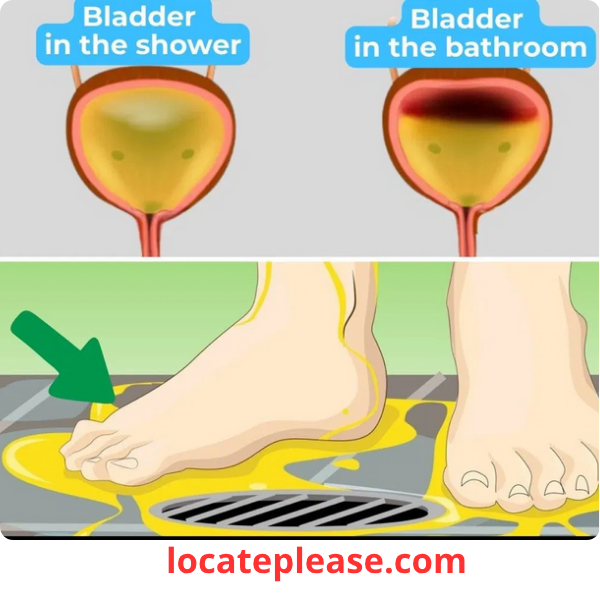Let’s talk about something millions do but almost no one admits to:
👉 Peeing in the shower.
It’s quick. It’s convenient. And — despite the “ew” factor — it’s surprisingly common.
But is it gross? Harmful? A bathroom crime?
Spoiler: No. Not really.
In fact, when done thoughtfully, peeing in the shower isn’t just harmless — it might just be a small act of hygiene, efficiency, and environmental rebellion.
Let’s dive into the truth — from science to sustainability — and why this quiet habit might be smarter than you think.
✅ Why It’s Actually Safe (For Most People)
1. Urine Is Sterile (In Healthy Bodies)
Yes, really.
In a healthy person, urine is not “dirty.”
It’s about 95% water, with small amounts of urea, salts, and creatinine — all natural byproducts of metabolism.
Unlike feces, urine doesn’t contain harmful bacteria as it leaves the body — so it doesn’t pose a health risk in a clean shower.
2. Showers Are Designed to Handle It
Think about what goes down the drain every time you shower:
- Sweat
- Dead skin cells
- Soap scum
- Shampoo residue
- Hair
- Dirt and oils
Compared to that, a little sterile urine is nothing.
And thanks to the constant flow of water, it’s rinsed away immediately — no lingering, no buildup.
⚠️ When It Might Not Be Ideal
While peeing in the shower is generally safe, there are a few exceptions:
1. Shared Showers = Shared Etiquette
If you’re living with roommates, family, or a partner — ask first.
Even if it’s harmless, some people are uncomfortable with the idea.
Respect matters more than convenience.
2. Unclean Showers
If your shower has moldy grout, porous tiles, or hasn’t been cleaned in weeks, urine could leave behind a faint odor over time — especially in corners or crevices.
👉 Solution: Clean your shower regularly — for many reasons, not just this one.
3. If You Have a UTI or Infection
While urine is usually sterile, certain infections (like UTIs) can introduce bacteria (e.g., E. coli) into your pee.
In communal showers, this could theoretically pose a minor risk — so it’s best to avoid it during illness.
🚿 Peeing in the Shower: The Etiquette Guide
Want to do it the right way? Follow these simple rules:
- Aim for the drain — Avoid splashing or missing the flow.
- Let the water rinse it for a few seconds — Just like soap, it washes away.
- Keep your shower clean — Regular scrubbing prevents any buildup or smell.
- Respect shared spaces — Silence is golden — or just ask.
💡 Pro tip: If you’re unsure, do it at the end of your shower — when you’re already rinsing everything down the drain.
🌍 The Environmental Perspective: A Tiny Act, Big Impact
Here’s where it gets interesting.
Every time you flush a toilet, you use 1.6 to 3.5 gallons of water (even more in older models).
If you pee once a day in the shower instead of the toilet, you save:
- ~584 gallons of water per year (with a 1.6-gallon flush)
- Multiply that by millions of people? That’s billions of gallons saved.
💧 Water conservation
📉 Less strain on sewage systems
⚡ Lower energy use at water treatment plants
It’s a micro-habit with macro-impact — a quiet way to reduce your water footprint without changing your lifestyle.
🧠 The Psychological Angle: Breaking Taboos
Why does peeing in the shower feel “wrong” to so many?
Because society has taught us that:
- Toilets = for pee/poop
- Showers = for cleaning
Mixing the two feels like a rule break.
But let’s be real:
Both go down the same drain.
Both end up at the same treatment plant.
So why is one “clean” and the other “gross”?
👉 It’s not logic. It’s conditioning.
And sometimes, doing something small that society says is “taboo” — but is actually harmless — feels weirdly liberating.
Like:
- Eating dessert first
- Wearing socks with sandals
- Putting fries in a milkshake (don’t knock it ‘til you’ve tried it)
It’s rebellion in a rinse.
🏗️ Design & Infrastructure: Should Showers Be Pee-Friendly?
Plumbing systems are already built to handle it — most shower and toilet drains merge into the same wastewater line.
So why not design for it?
Imagine:
- Dual-flush systems that encourage shower-peeing
- Public showers at gyms or festivals with designated “pee zones”
- Water-saving campaigns that normalize the practice
We flush trillions of gallons of drinkable water down the toilet just for pee — one of the cleanest substances we produce.
Maybe it’s time to rethink the rules.
🌐 Cultural Lens: What’s Normal Where?
Attitudes vary widely:
- In some European and Latin American countries, peeing in the shower is more accepted — seen as practical and eco-conscious.
- In others, it’s considered taboo or unhygienic, despite no real risk.
Culture shapes behavior — but science says:
👉 It’s okay.
Final Thoughts: Pee Smart, Save Water, Stay Calm
Peeing in the shower isn’t for everyone — and that’s fine.
But if you do it (or want to), know this:
You’re not being gross.
You’re not breaking hygiene rules.
You might even be helping the planet.
So next time you’re under the hot water, feel that urge, and think:
“Do I really need to get out, dry off, walk to the toilet, flush, and come back?”
Maybe not.
Stay in.
Let go.
Let the water carry it away.
Because sometimes, the most sustainable choice is also the most convenient.










